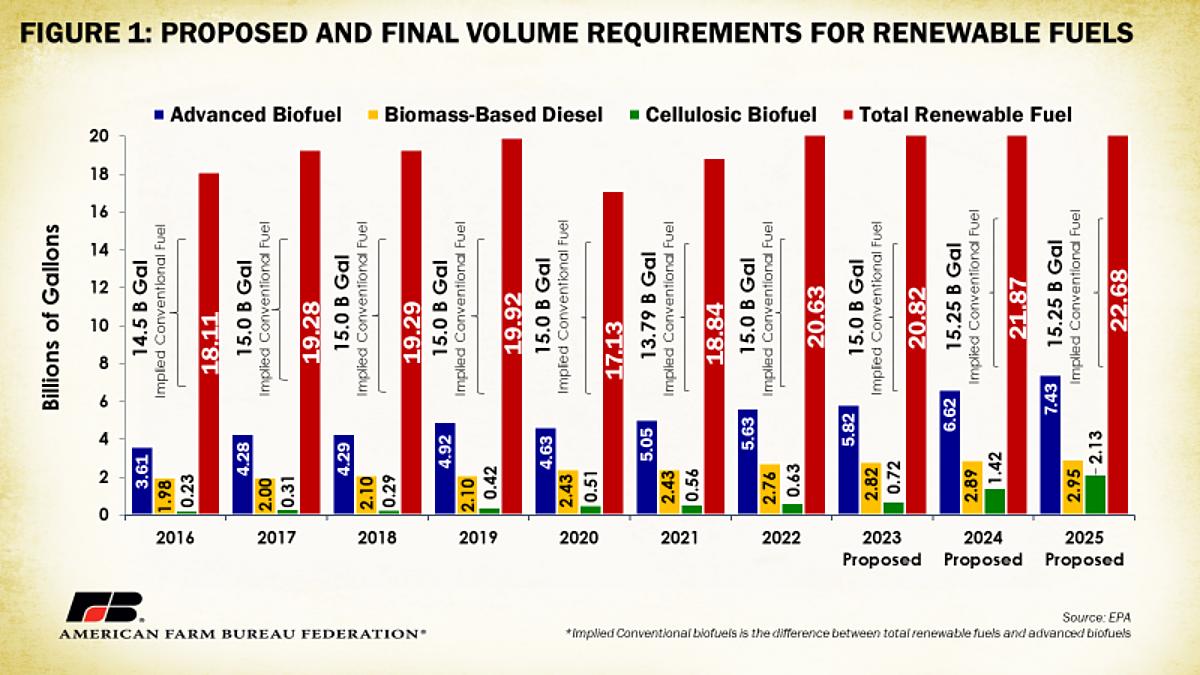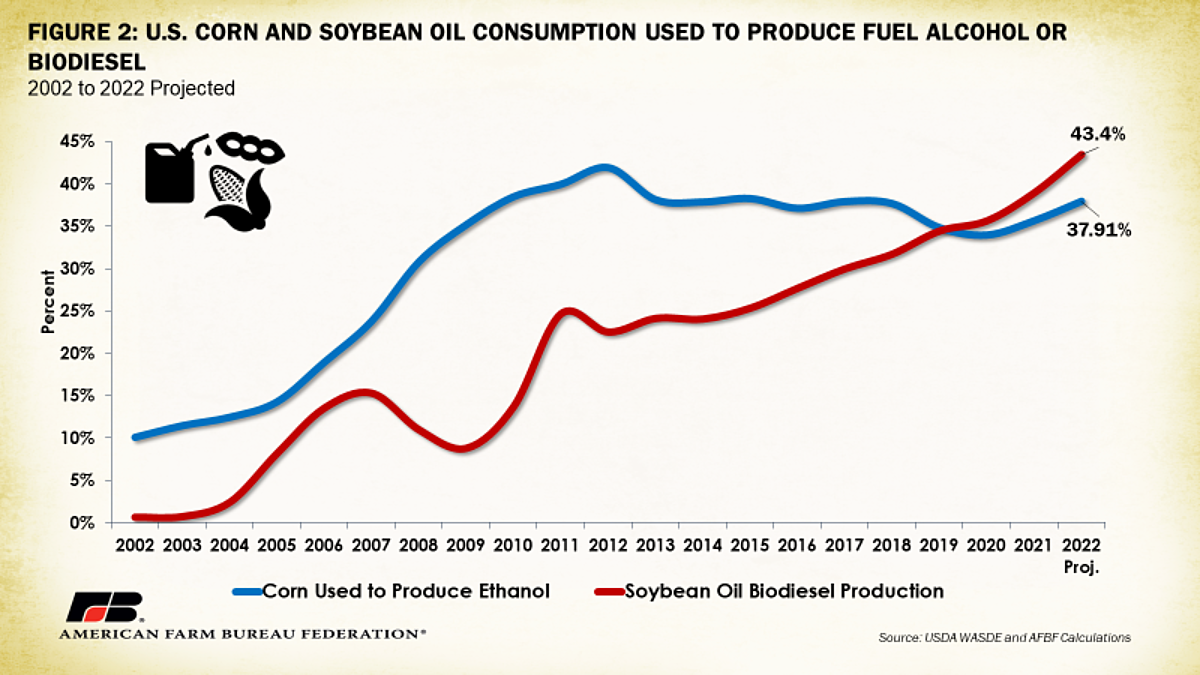EPA Proposes Renewable Fuel Standards for 2023, 2024 and 2025
Bernt Nelson
Economist
The Renewable Fuel Standard (RFS) program was created in the Energy Policy Act of 2005 to reduce greenhouse gas (GHG) emissions, grow the nation’s renewable fuels sector and reduce reliance on imported oil, based on required use of renewable fuels to satisfy Renewable Volume Obligations (RVO) – volumes of fuels of various categories that the liquid fuel industry were required to incorporate into their supply. The program was expanded under the Energy Independence and Security Act of 2007. On Dec. 1, 2022, EPA proposed a multiyear rule that established required Renewable Volume Obligation (RVO) targets and percentage standards for 2023 to 2025 and proposed modifications to the RFS program. This Market Intel provides analysis on changes to the RFS standards and their potential impacts on farmers.
Background:
The national Renewable Fuel Standard program requires a certain volume of renewable fuel be used to replace petroleum-based fuel. The RFS is currently developing RVOs using four renewable fuel categories: total renewable fuel, advanced biofuel, cellulosic biofuel and biomass-based diesel. Under section 211 of the Clean Air Act, EPA is required to set renewable fuel percentage standards every year. EPA has historically released its proposed RVO requirements for each of the categories in June or July. This proposed rule is subject to public comments and, potentially, revision based on those comments, which are due on Feb. 10. EPA is required to release its 2023 RVOs by June 14 under a consent decree reached between EPA and Growth Energy, a national biofuels association.
What’s in the Proposed Rule?
The proposed rule would increase total renewable fuel volumes by 2.05 billion gallons to 22.68 billion gallons by 2025. This would include an increase of 940 million gallons in 2023, another 1.05-billion-gallon increase in 2024, and a final increase of 810 million gallons in 2025. The 2022 biofuel mandate adds 250 million gallons of conventional biofuel (largely assumed to be corn-based ethanol) required under statutory levels. Figure 1 illustrates the final volume requirements from 2014 to 2022, and the proposed volume requirements from 2023 to 2025.

Biomass-based diesel is a category that includes biodiesel, renewable diesel, heating oil or jet fuel that meets the definition of either biodiesel or renewable diesel that reduces GHG emissions by 50%, per gallon of comparable fossil fuel. The proposed rule would increase biomass-based diesel RVOs by 60 million gallons to 2.82 billion gallons in 2023, by 70 million gallons to 2.89 billion gallons in 2024, and by 60 million gallons to 2.95 gallons in 2025. The RVO is calculated by subtracting total advanced biofuel from total renewable fuel. According to U.S Bioenergy Statistics published by USDA’s Economic Research Service (ERS), the United States had the capacity to produce 2.25 billion gallons of biodiesel from 72 plants on Jan. 1, 2022. When combined with renewable diesel, the overall capacity from 83 total plants is estimated at over 4 billion gallons. USDA’s Higher Blends Infrastructure Incentive Program has already supported infrastructure for an addition 1 billion gallons of biodiesel capacity.
Advanced biofuel is derived from qualifying renewable biomass other than cornstarch and meets a 50% GHG reduction threshold and includes biomass-based diesel, cellulosic biofuels and other advanced biofuels. Outside of biomass-based diesel and cellulosic biofuels, which have their own RVO, other advanced biofuels include ethanol derived from sugarcane (largely imported from Brazil) and oil-like hydrocarbons such as the four-carbon alcohol butanol. The proposed rule increases the RVO requirement for advanced biofuels by 190 million gallons in 2023, 800 million gallons in 2024 and 810 million gallons in 2025. ERS estimates that the United States had a total capacity for advance biofuels including renewable diesel and other biofuel capacity of 1.75 billion gallons from 11 total plants on Jan. 1, 2022.
Renewable (or implied conventional) fuel refers to biofuel, including ethanol, derived from starch feedstocks. It must meet a 20% GHG reduction threshold and is the only RFS subset that can use ethanol to meet its biofuel requirement. The implied conventional biofuel requirement proposed by EPA is 15 billion gallons for 2023 and an additional 250 million gallons for a total of 15.25 billion gallons in 2024 and 2025. The RVO was returned to 15 billion gallons in 2022 following a 1.21-billion-gallon decrease in the RVO in 2021.
Renewable Identification Numbers under the Renewable Fuel Standard Program
Renewable Identification Numbers (RINs) are the currency of the RFS program. A RIN is attached to each gallon produced. Participants in the market, including refiners and importers of gasoline or diesel, renewable fuel producers and exporters, and registered RIN market participants trade RINs in the form of either assigned RINs or separated RINs. An assigned RIN is directly associated with a batch of fuel and remains attached to that batch of fuel as it moves from party to party. A separated RIN was formerly assigned to a batch of fuel but is no longer attached to a batch. RINs can be bought, sold or separated to meet the needs of market participants, and to allow for greater efficiency in meeting RFS requirements. Eventually the RIN is used to meet RVOs and is retired at that time.
e-RINs
The EPA rule has also proposed the addition of a RIN-generating pathway for electricity made from renewable biomass and used as transportation fuel. “e-RINs,” generated by manufacturers of light duty electric vehicles, would provide a pathway for qualifying renewable electricity only. The vehicle manufacturers would generate e-RINs based on establishing contracts with generators of renewable electricity specifically derived from biomass, the proposal does not include electricity generated from solar or wind. When finalized, the system is intended to provide greater beneficial use of landfills and digesters as a source for renewable energy.
Incentives
The Inflation Reduction Act of 2022 extends biodiesel, alternative fuel and second-generation biofuel tax credits through the end of 2024. Under these provisions, a biodiesel blender may be eligible for a tax credit of $1 per gallon of pure biodiesel, agri-biodiesel or renewable diesel blended with petroleum diesel to produce a mixture containing at least 0.1% diesel fuel. To be eligible, blenders must have produced and sold or used the qualifying biodiesel blend as a fuel in their business.
Impacts on Corn, Soybean Oil and Soybeans
The initial result of the additional 250 million gallons of conventional renewable fuel is an 88-million-bushel increase in corn needed for ethanol in both 2024 and 2025 for a total impact of 166 million bushels. This provides support for corn markets while at the same time reducing the use of petroleum-based transportation fuels and reducing GHG emissions.
On the soybean side, U.S biomass-based diesel supplies (including imports) were about 3.1 billion gallons in 2021 and about 3.2 billion gallons in 2022. USDA projects 11.6 billion pounds of soybean oil will be used to produce biodiesel during the 2022/23 marketing year, up nearly 180% over the last five years. The use of soybean oil for biodiesel production, as a percent of total consumption, surpassed the use of corn for ethanol production in 2020 and has continued to climb (Figure 2). EPA’s proposed rule sets RVOs for biomass-based diesel at 2.82 billion gallons for 2023, 2.89 billion gallons in 2024, and 2.95 billion gallons in 2025. According to the proposed rule, the 2.95-billion-gallon RVO for 2025 would be about 8% below 2022 supply levels. The RVO lagging behind available supply will limit the RFS’s short-term positive price impact on RIN’s and biofuels, and limit the incentive to growth in the biomass-based diesel industry.

Key Takeaways
Renewable fuels provide a significant and steady market for American growers. In the 2022/23 marketing year, 5.28 billion bushels of corn, or nearly 38% percent of total U.S. consumption, were used by ethanol producers. In the 2022/23 marketing year, 11.6 billion pounds of soybean oil, the oil from nearly 974 million bushels of soybeans, were used in biodiesel production (Figure 2).
The proposed volume increases raise the floor for demand in the biomass-based diesel and advanced biofuel sector; but as long as they lag behind current supply, they will not incentivize continued growth in a sector that has made a substantial contribution to corn and soy demand for American farmers, and to the overall sustainability of American energy supplies.
Trending Topics
VIEW ALL
